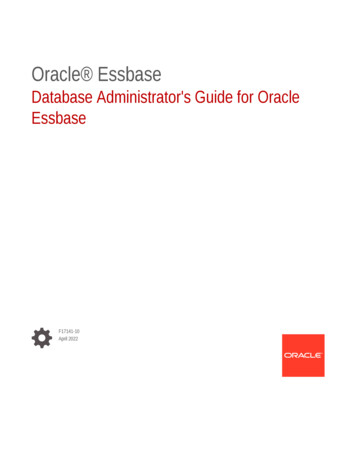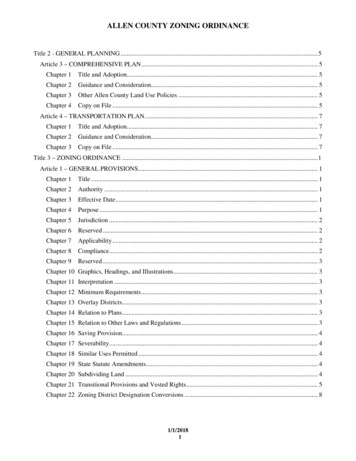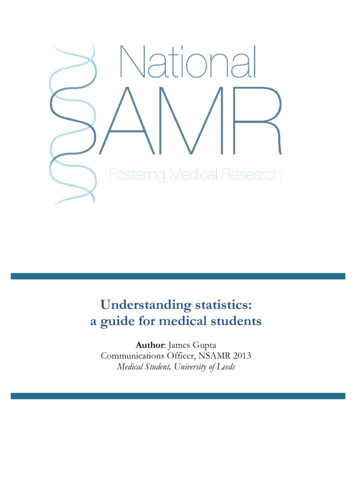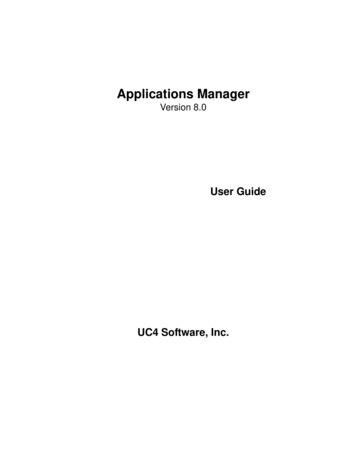
Transcription
A COMPREHENSIVE GUIDE TOUnderstandingLIMS
Table of ContentsWhat is a LIMS? . 3How LIMS Helps Laboratory Compliance . 8What is a SaaS LIMS? . 12Reasons Why Labs Invest in SaaS LIMS Technology . 15How to Tell If Your Lab is Ready for LIMS . 19How to Evaluate a LIMS for Your Lab . 21Implementing a LIMS Solution . 26How Much Does a LIMS Cost? . 28LabWare LIMS - Self-Hosted v. PaaS v. SaaS . 36About LabWare . 39A Comprehensive Guide to Understanding LIMS2
What is a LIMS?A Laboratory Information Management System (LIMS) is an application builtaround a centralized database of samples and any meta data, results,workflows, and instruments associated with them. This not only allows alaboratory to remain organized, but also facilitates efficiency, transparencyand compliance.How Does a LIMS Work?The central reason to implement and use a LIMS is to log, track, record andreport on samples and scientific data in a structured, consistent manner.Although LIMS QA/QC testing capabilities have grown exponentially ascomputers and mobile devices have become everyday parts of life evenbeyond the laboratory, the core function has stayed the same: documentingand tracking a sample through its entire lifespan, from when it is initially created,introduced into the lab and through to its usage and disposal.The central reasonto implement anduse a LIMS is to log,track, record andreport on samplesand scientific data.A Comprehensive Guide to Understanding LIMS3
The precise level of sample tracking and reporting that is possible with a LIMSmakes it easier to comply with laboratory best practices (GMP, GLP). Becausea LIMS automatically records certain data, laboratories can spend less timemanually tracking, logging and reporting, and more time optimizing theirprocesses for higher throughput and accuracy. Better sample maintenance andhandling means more reliable experiments and results.There are four key considerations to keep in mind to understanding how aLIMS works:1Consistent sample management is tricky and time-consuming. Beforethe regular implementation of LIMS, individual researchers would devisetheir own naming schemes and would hand-document their samplesas well as their usage; aside from how time-consuming this was, it alsoopened a lot of room for error. With a LIMS, a barcode can be assignedto each sample, which is scanned during major sample lifespan eventslike storage and usage, driving accuracy and consistency in how samplesare managed.2Interactions with machines can improve documentation and workflows.Many LIMS can now connect to laboratory equipment. They can importsample details or export sample data, whether for storage or straightinto other applications for further processing or analysis. Many LIMSwill even read errors from testing or experimental runs and flag themwhen appropriate, or they move the samples onto other protocols orequipment for further investigation or experimentation.A Comprehensive Guide to Understanding LIMS4
3Automatic reporting and visibility of sample data. LIMS monitors thesample’s entire journey in the laboratory, and so it necessarily has the sortsof information needed for reports, decision making and audits as wellas ensuring quality controls. Because LIMS usually stores data centrally,often in the cloud, it’s easy for scientists to access up-to-date, real-timeinformation, no matter if they’re in a lab, at home, or even on the road.4Data integrity can be maintained. Without LIMS, there is extensiveroom for error when it comes to sample data collection, and even themaintenance of a chain of custody. Manual documentation can rapidlybecome cumbersome and error prone, particularly as the number ofsamples being tested together grows—and this can happen often,particularly in a testing environment with extensive controls and significantanalysis replication.How Does a LIMS Work?A Comprehensive Guide to Understanding LIMSLearn More5
What Do Laboratories Use LIMS For?Let’s look at some of the top ways and goals towards which laboratoriesimplement LIMS and meet their everyday needs:Sample Management - BeingLot Management and ReleaseStability Study Management - A good LIMS will allowable to document, track, and- A central LIMS helps monitorscientists to set up and manage an inventory of samples tomanage inventory relating tonot just batch usage but alsostudy the impacts of storage at various temperatures andcontrols and samples helpsbatch performance, andhumidities, track that samples are tested when neededscientists have what theyalso allows for the trackedand that the correct tests are performed, and help predictneed, when they need it—distribution of lots amongfuture degradation through data trending. These studiesand eliminates the time-sucklab members. As data foroften involve multiple batches and are often a complexand errors that come withprevious similar batches ismatrix of testing and last years, making manual controlsmanual processes.readily available, results canand processes unreliable and prone to error—particularlybe seen in the wider contextfor laboratories managing multiple products.of a product rather than thenarrow view of a single batch.Minimize ResourceConsumption - Becauseindividual lab membersEnvironmental Monitoring - A LIMSReporting to Clientscan help with regular testing ofa manufacturing environment,Reporting Internally(CROs) - Being able toincluding before and after- From institutionaldocument sample datachecks for a batch manufactureaudits through routineaccurately and thoroughlyor the quality of water throughoutlaboratory maintenance,confers the highest levela distribution system. This ensuresLIMS creates auditof transparency. Anyonereliable traceability for eachtrails that accuratelyexamining the data from asample taken back to the peopledocument samplelaboratory run to these highand/or environment that couldstorage, consumption,standards can place trust inpotentially be impacted by theand even sample resultsthe outcomes, which makesdetection of unwanted bacteriaand their subsequentexternal reporting a positiveor inappropriate quality.data analysis.experience.A Comprehensive Guide to Understanding LIMSdon’t need to spend timetrying to accurately collectand organize all of the datasurrounding their samples,they can spend more timedoing the work and analysis.Additionally, use of a LIMSmakes it quick and easy tofind samples, which saves timeand cost trying to hunt downor potentially regeneratenecessary samples.6
What’s the Difference between LIMS and LIS?A LIMS is often referred to as a Laboratory Informatics Software (LIS), LaboratoryAutomation Software (LAS), or Laboratory Management Software (LMS), but attimes this is a misnomer. A LIMS and a LIS are actually not equivalent. Althoughthey serve similar functions are typically found in different laboratory settings.A LIMS is found in industrial settings, such as pharmaceutical labs, where theyhandle batches of samples and follow both FDA guidelines as well as goodmanufacturing and laboratory practices (GMP, GLP).A LIS, on the other hand, is found in clinical settings, where they report onindividual patient samples and must comply with HIPAA, as well as guidelinesfrom hospital accreditation agencies. Some of the more feature-rich LIMS canactually perform both these roles.How LIMS Works with ELNsA LIMS can be used in conjunction with an electronic lab notebook (ELN), whichorganizes lab experiments and can be highly personalized for each individual useror test being performed. They can overlap in referring to samples and trackingsample outcomes, but ELNs tend to focus on individual experiments, while a LIMSwill center around tracking samples and collecting and reporting data.A LIMS and a LIS are actually notequivalent. Although they serve similarfunctions are typically found in differentlaboratory settings.A Comprehensive Guide to Understanding LIMS7
How LIMS HelpsLaboratory ComplianceWhen examining LIMS software, lab managers should first scrutinize thevalidation process used, as this is what sets a lab up for compliance. Then, labmanagers should make sure that the features driving compliance line up withthe laboratory’s needs.Features of LIMS Software that Drive ComplianceThere are three key aspects to how LIMS software drives laboratory compliancewith regulations and best practices: organization, visualization, and automation.OrganizationOrganization creates the framework in which best practices may be carried out.It all starts with standardizing the data collected by defining and configuringthe required and desired parameters, so that they may be recorded and storedconsistently over time.Organization createsthe framework inwhich best practicesmay be carried out.A Comprehensive Guide to Understanding LIMS8
One internal checkpoint that is part of protocol management involves testingstability study samples, where testing is done for each sample to ensure integrityover time; this data must be collected regularly, with all fields filled for eachsample, in order to paint an accurate picture of the samples as well as oftheir storage.Organization also includes maintaining accurate records of the chain ofcustody, from sample receipt through storage as well as any tests or protocolsperformed with the samples. Before the implementation of LIMS software,laboratories may have inefficient naming schemes, with individuals handdocumenting all aspects of their sample handling, storage, and usage; in turn,this opened the door to everything from human error through tampering. WithLIMS, the use of barcodes attached to individual samples drives accuracy,consistency, and accountability.VisualizationVisualization helps lab managers and any other concerned lab membersto report on sample testing and usage, and recommend optimizationswhere needed.The fact that all sample data is collected electronically makes it easy to compileinto reports. As data becomes available across multiple timepoints, trends maybecome visible that in turn can be used to improve lab operations or interceptcompliance issues before an audit. And rather than enforce a police state, thedata is visible and transparent for all users; everyone in the lab has access to thetools they need to drive compliance with best practices.A Comprehensive Guide to Understanding LIMS9
Visualizations also make it easy to set and monitor key performance indicators(KPIs), and to obtain a birds’ eye view of laboratory processes. This can helpidentify points of strength as well as vulnerabilities, which need not be noncompliance—even inefficiencies count here. There are a wide number ofreasons why inefficiencies may occur, ranging from lack of training throughoverburdened lab members; being able to spot these inefficiencies is the firststep toward correcting them and preventing further escalation.Adding power to the organization and visualization of LIMS software is theworkflow automation, which removes human error while allowing for furtherpower in documentation. The software itself comes pre-configured to containbest practice workflows that adhere to GMP and GLP requirements, and thatare recognized by auditors. These workflows are complete, with all necessarytracking built-in from start to finish.A Comprehensive Guide to Understanding LIMS10
AutomationAutomation allows the LIMS software to capture more details than could becaptured manually.The data captured by the system is more accurate, especially if theLIMS can communicate directly with lab instrumentation and associatedsoftware. Transcription errors are completely avoided since documentation isautomatically performed within the software platform. A quality LIMS softwaretakes things a step further by flagging any items that fail specifications so thatthey cannot be released without further review.Between automation and organization, LIMS software creates and enforces acomprehensive, accurate audit trail. This trail accounts for all samples and theirassociated results, while also capturing all changes made to samples, tests,and results.LIMS softwarecreates and enforcesa comprehensive,accurate audit trail.How the Best LIMS SoftwareCan Help Your Lab ComplianceA Comprehensive Guide to Understanding LIMSRead More11
What is a SaaS LIMS?Cloud computing and software-as-a-service (SaaS) models make the very besttools in the world accessible for any laboratory analytical testing environment.With cloud-based tools, lab managers: Don’t need an IT department Don’t have to worry about system validation Don’t have to go through large upgrade projects Don’t have to spend time maintaining these lab automation systems.Without the burden of worrying about their software, lab managers and theirteams can actually focus on their jobs. Put another way, they can focus onscience not systems!Advantages of Using a SaaS LIMSRapid deploymentWithin as quickly as thirty days, a SaaS LIMS can be fully deployed andlive. SaaS LIMS drives the adoption of best practices. In parallel, significanttime and cost from implementation and onboarding are saved.Without the burden of worrying abouttheir software, lab managers and theirteams can actually focus on their jobs.A Comprehensive Guide to Understanding LIMS12
Pre-configured workflowsValidated, pre-configured workflows that are known to effectivelysupport laboratory operations are part of what is expected in a LIMS.Because the system was designed with an understanding of regulatoryrequirements across industries, best practices are baked in —includingbarcodes and unique identifiers to track each sample through theentire testing process.Fully validated systemAn already-validated system can save as much as 30-50 percent of thetotal system cost, reducing or eliminating required testing, validation,due diligence on requirements and documentation processes needed.Affordable yet reliableAn established SaaS LIMS functions effectively by reliably storinginformation on the cloud and operates smoothly, without lags orcrashes, by requiring minimal local resources. In fact, it’s hosted onweb browsers, and so it doesn’t need powerful or expensive PCs inorder to run.Within as quickly asthirty days, a SaaSLIMS can be fullydeployed and live.A Comprehensive Guide to Understanding LIMS13
Secure environment for your dataA SaaS LIMS offers the highest standards of security, both within theapplication as well as at infrastructure levels. With a traditional LIMS,security is in the hands of the company deploying the LIMS; they incuradditional costs as they work to protect their information from threatsranging from viruses through intruders.Accessible on any browser anywhereUnlike LIMS hosted in-house, SaaS LIMS offers the advantage of notrequiring a firewall or operating on a VPN. All that is needed for entryinto a SaaS LIMS is a username and password.Data integrity complianceThe FDA and MHRA have increasing expectations, regulations andguidance for data integrity, including 21 CFR Part 11 and the latest FDAand MHRA Regulatory Data Integrity guidance.15 Advantages of aSaaS LIMS SolutionA Comprehensive Guide to Understanding LIMSRead More14
Reasons Why Labs Invest inSaaS LIMS TechnologyWhen you work with a fully-functional cloud-based LIMS, you are gainingthe peace of mind knowing that your metadata, workflows, samples, resultsand instruments are completely organized at all times. Since these importantplatforms center around the need to track samples, collect and report data,your SaaS LIMS platform provides a flexible and extensible solution to presentingdata in a clear and cohesive fashion for a variety of different audiences.1. Greater Backup and DisasterRecovery CapabilitiesBacking up your laboratory data and resourceinformation to the cloud is the first step increating a robust business continuity anddisaster recovery strategy. Your LIMS providershould be able to offer uptime guarantees aswell as share information with you regardingthe redundancy of backups and where yourinformation is being stored. The security levelsfor any data centers are also a consideration foryour team and you should ensure that your LIMSprovider is able to provide the level of access tosupport personnel and quick response times inthe event of an urgent need, too.A Comprehensive Guide to Understanding LIMS15
2. Navigate ComplexRegulatory EnvironmentIt is increasingly difficult to maintain the dataintegrity and validation required by regulatoryauthorities, particularly as expectations continueto rise. Without the automation involved with asophisticated cloud-based LIMS, your laboratoryteam may struggle to consistently comply withreporting standards unless they are automatedand built into your system processes. Any LIMSthat you select should be flexible and extensibleenough to support evolving requirements,creating a stringent approach to navigatingcomplex regulatory environments.3. Lessen or Eliminate Audit FailuresAudits can be a painful fact of life forlaboratories, and failures can be expensiveand time-consuming to resolve. With an activeand well-configured LIMS in place, you lessenor eliminate these audit failures by showingthat your team is following even the mostcomplex procedures through automationand process control. If you do fail an audit,leveraging your LIMS to bring processes backinto alignment can help you overcomethese challenges quickly and validate yourapproach to the resolution.A Comprehensive Guide to Understanding LIMS16
4. Standardize Laboratory OperationsConsistency is one of the hallmarks of solid laboratory operations, and thatcomes most efficiently from standardized operations. Human errors inherent inmanual processes are inefficient, making it difficult to scale, share or report onyour results. Creating dependable processes and putting them together into atrusted workflow reduces the stress and overhead required to perform the dailytasks and activities that are required to deliver results.Compliance requirements often center around ensuring your processes are fullyvalidated within your user environment, making consistency of operations anextremely important aspect of any LIMS. Creating standardized and automatedsolutions helps reduce manual effort, resulting in lowered costs and moreefficient operations. Using a LIMS solution allows you to track data trends acrossgeographic barriers, reducing limitations on analysis options and improvinginterpretation.A Comprehensive Guide to Understanding LIMS17
5. Consistently Track KPIsIf you are frustrated with the time requiredto wait around for results in your reporting,an updated SaaS LIMS offers unique valuefor your team. Keeping track of the mostimportant KPIs and defining complex metricreports becomes more straightforwardwhen your resource allocation and resultsare stored in a central location. The simpletask of running reports can happen morequickly than you expected, with automatedworkflows, dashboards and other optionsthat will help ensure that you are keepingtrack of the most important KPIs to expeditegetting results within your laboratory.If you are frustrated with the timerequired to wait around for results in yourreporting, an updated SaaS LIMS offersunique value for your team.8 Reasons Why Your LaboratoryNeeds a SaaS LIMS SolutionA Comprehensive Guide to Understanding LIMSRead More18
How to Tell If Your Labis Ready for LIMSWhether you already have a LIMS in place and are considering an upgrade tothe cloud or have considered adding this type of platform for some time, hereare signs that your laboratory operations could benefit from deploying aSaaS LIMS:Lack of a Dedicated Internal IT TeamWhen you don’t have access to internal IT professionals that can dig deepinto the inner workings of your LIMS, it can be particularly difficult to get theday-to-day support that your teams will need to be successful. With a SaaSLIMS solution, upgrades and enhancements are rolled out via a cloud-basedconnection so you always have access to the most secure and reliable versionof the solution that also contains the latest enhancements.With a SaaS LIMSsolution, upgradesand enhancementsare rolled out viaa cloud-basedconnection.A Comprehensive Guide to Understanding LIMS19
Interest in Minimizing Impact on Internal OperationsTying your resources up with an on-premise LIMS software implementation maynot be the most efficient use of laboratory team members’ time. With SaaS LIMSsoftware from a trusted technical partner, it’s often possible to minimize theimpact on your internal operations so you can continue revenue-generationopportunities that will help boost innovation for the future.Need for a Distributed FootprintStoring your data in a single location can be a recipe for disaster, particularly forlong-term projects and regulated testing that requires a high level of security.With a SaaS LIMS solution, you are able to not only store information securelyand remotely but you can also gain access to information from a variety oflocations. With on-premise software, users are often restricted to only accessingdata or business applications from within a corporate location but SaaS LIMSoffers increased options.Strict Requirements for Regulatory ComplianceWhen you adopt predefined workflows that are already in full compliancewith industry regulations, it can provide a secure base for your operations. Witha SaaS setup, your LIMS can be implemented with standardized practices,processes, and controls, easing you quickly into a more compliant solution.10 Common Characteristics ofLabs That Benefit from SaaS LIMSA Comprehensive Guide to Understanding LIMSLearn More20
How to Evaluate aLIMS for Your LabLabs using manual or older systems might be putting their workflows andcompliance costs under undue stress. Consider if your current system is savingyou money and time -- or perhaps, actually increasing your expenses. If it iscosting you money and time, this presents an opportunity to find an updatedsystem that can streamline processes and track data for increased efficiencies.Before considering if it’s time to update your systems, here’s what you need toknow to conduct a needs analysis of your current workflow and systems.Analyze Your Lab’s Current Workflow, Systems, and NeedsDiscover what current processes are causing a barrier to meeting regulatorystandards and where you need to create greater efficiencies that are costingyou time and money.Processing of SamplesThe central reason to implement and use a LIMS is to log, track, record,and report on samples and scientific data in a structured, consistentmanner ensuring a reliable chain of custody. The processing of samplesmust produce accurate results every time.Any samples required to be tested, need to comply with an establishedschedule ensuring both the required tests are carried out, and correcttesting is performed on a consistent basis.A Comprehensive Guide to Understanding LIMS21
Laboratory OperationsA good laboratory manager should look for ways to improve quality,efficiency, and compliance. Physical space and budget spend arealways under scrutiny in a laboratory setting requiring lab operationsto run efficiently and effectively. Any manual processes are at risk ofhuman error making it difficult to scale, share, or report on your resultswith any degree of accuracy and consistency.Any options that utilize automation gives you control and flexibility todeliver quality outcomes. A major benefit of using a LIMS solution isprocess automation reducing the risk of human error.Data ReportingData reporting is equally important in understanding how efficient yourworkflows are and to reveal if anything is undermining the quality of products,systems, and processes. It’s important your solution meets the challengingregulatory environment in your industry keeping the integrity of the data.LIMS software improves data reporting as it makes it easy to report on allactivities. A LIMS ensures all data is stored and processed consistently throughan automated process, giving you greater transparency and accuracy.A Comprehensive Guide to Understanding LIMS22
Understand Users and Stakeholders in ImplementationThose who will be involved in the implementation depends on the solution. Forinstance, if you are implementing a SaaS system, all you need are laboratorypersonnel because you are merely training and deploying and loading somemetadata. You will want a Laboratory Manager and Data Administrator to getthe information needed to be loaded to the specifications to your individualcompany needs.If you are going down the configuration route, it depends if you are doing anon-site infrastructure or a hosted infrastructure route. If you are going downan onsite infrastructure route you will need subject matter specialists fromeach area plus an overall business lead, IT leads and specialists on hardware,software, and networking infrastructure which can be very costly.Stakeholders can include:Lab ManagerQuality ManagerThe laboratory managerThe Quality Manager will beThe scientist/analyst wantsis responsible forusing the LIMS, whether it’sto know what work needsall workflows, worka dedicated QA/QC role orto be done and whatassignments, andjust the responsible personwork has been assigned toworkload managementin the lab. They are thethem. They are going to useplus the monitoring ofperson that would normallythe system to documentKPIs and data reporting.release the batch and theperforming the testslast person to sign off on theand complete the initialCertificate of Analysis.assessment of the sample.A Comprehensive Guide to Understanding LIMSScientists/Analysts23
Research and Conduct Vendor DemosWhen you are starting your research process you can go online and look atsoftware comparison sites such as G2, Capterra, and TechValidate.It’s critical to look for a company with a long history of reliability and experienceimplementing in your specific environment. You need a company that is stablebecause you want your data to be safe. You need to consider the scalabilityof a system because you don’t need the same system for a lab of five peopleversus a lab of 1,000 spread across 3 different countries.The next step is to schedule various providers to provide you with a demo of theirsoftware. Prior to this, highlight the functions that you want to have supportedand assess out of the box functionality to meet those functions. If those functionsdon’t meet your expectations, then discuss what you would need to closethe gap, which may take a second demo. It’s all about cost reduction - don’timmediately assume you’ll need to customize it to your vision of a system.Customization increases cost, effort and risk.You need acompany that isstable because youwant your data tobe safe.A Comprehensive Guide to Understanding LIMS24
Use Criteria to Evaluate LIMSThe next step is to compare each provider against the criteria lab managers shoulduse when evaluating a LIMS solution.LIMS evaluation criteria to consider: Features: How well does the solution fit with your workflows, or will you needadditional customization? Pricing: Is the solution offered on-premise or software-as-a-service? Will you belicensing or purchasing a subscription? Support: How will the vendor work with you through the design, implementation,and post-launch of the LIMS? Implementation Timeline: How much customization will you need, and whattimeline is expected to get the solution up and running? Vendor Experience: How much experience does the LIMS vendor have withinyour industry? Do they have any industry certifications to support their expertise?How to Evaluate a LIMSSystem for Your LabA Comprehensive Guide to Understanding LIMSLearn More25
Implementing a LIMS SolutionEvery strong implementation requires an honest, comprehensive review of alab’s needs and vulnerabilities, followed by a prioritization in addressing them.In many ways, an audit helps simplify this step by flagging the most criticalissues present. From there, evaluating a system will depend on selecting andpurchasing the system whose out-of-the-box core functionalities best align withthe lab’s needs. Less customization means a smoother implementation.Steps to Implementing a LIMS1Data Population: Once a system has been selected, there are twocommon ways in which the “master data”—or laboratory data andrequired fields–can be populated within the system. The more tediousoption involves relying on the user to manually populate all of the datain the system. The alternative—used by software-as-a-service (SaaS)platforms—is to have users supply master data to SaaS administratorsinside the platform, who then leverage preconfigured templates to easilyand rapidly populate required fields.2Training: Next, every lab member should be trained on using the LIMS. Thisis generally done through self-training guides, where individuals can go attheir own pace, and reference materials that relate directly to their dayto-day function.3Validation: Validation is a critical step. A SaaS LIMS platform should comefully-validated, and therefore provides administrators with validationpackages, the acceptance of which may depend on the laboratory’srisk tolerance. Some LIMS solutions
How the Best LIMS Software Can Help Your Lab Compliance Read More A Comprehensive Guide to Understanding LIMS 11 Automation Automation allows the LIMS software to capture more details than could be captured manually. The data captured by the system is more accurate, especially if the LIMS can communicate directly with lab instrumentation and .










